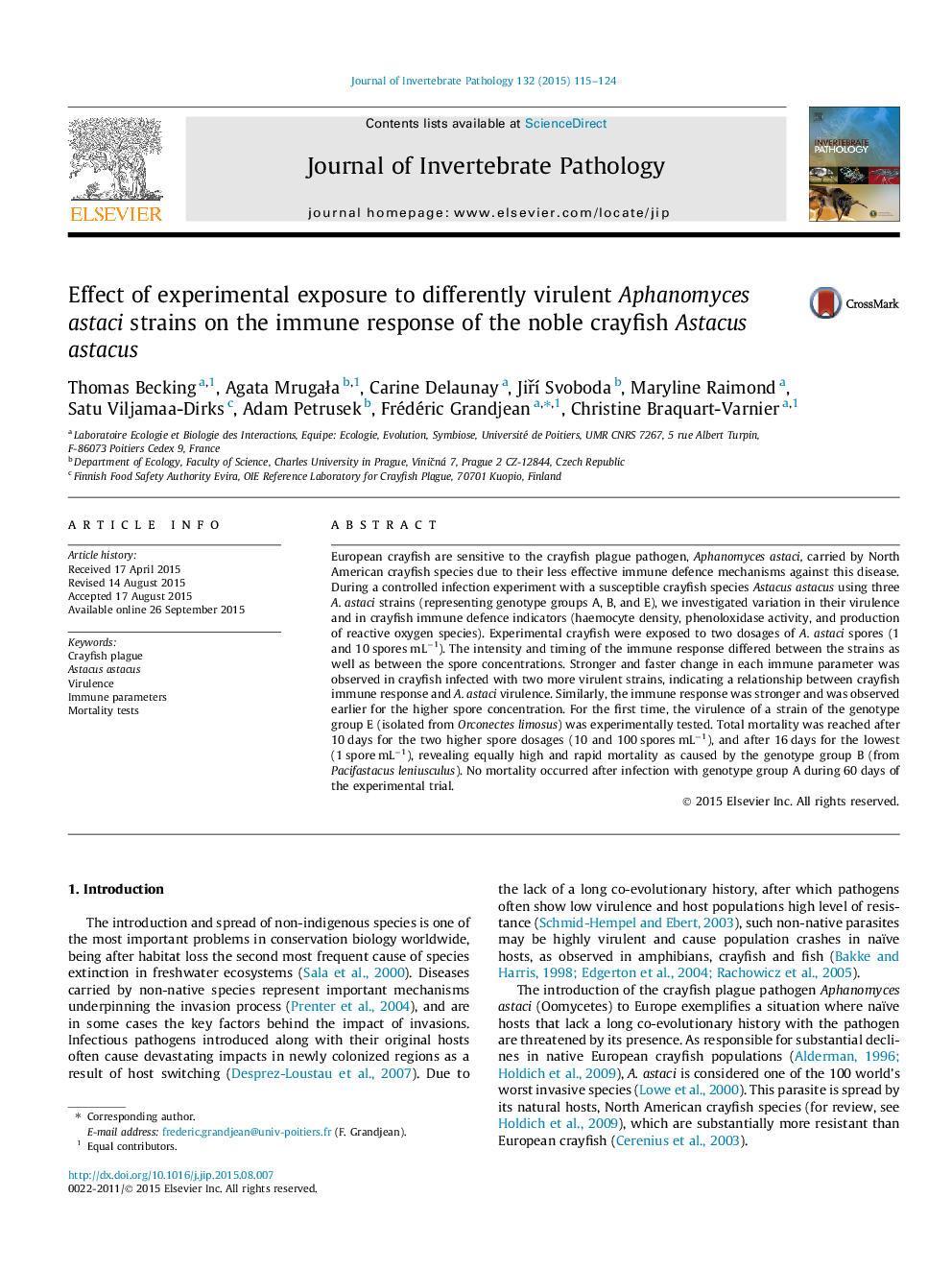| Article ID | Journal | Published Year | Pages | File Type |
|---|---|---|---|---|
| 6389376 | Journal of Invertebrate Pathology | 2015 | 10 Pages |
â¢All crayfish infected with the A. astaci strain (group E) died during the experiment.â¢We perform monitoring of immune parameters after plague infection.â¢A decrease in total haemocyte number is observed after infection by several strains.â¢We observed an increase in PO activity after infection.â¢The immune response depends on virulence of strains.
European crayfish are sensitive to the crayfish plague pathogen, Aphanomyces astaci, carried by North American crayfish species due to their less effective immune defence mechanisms against this disease. During a controlled infection experiment with a susceptible crayfish species Astacus astacus using three A. astaci strains (representing genotype groups A, B, and E), we investigated variation in their virulence and in crayfish immune defence indicators (haemocyte density, phenoloxidase activity, and production of reactive oxygen species). Experimental crayfish were exposed to two dosages of A. astaci spores (1 and 10 spores mLâ1). The intensity and timing of the immune response differed between the strains as well as between the spore concentrations. Stronger and faster change in each immune parameter was observed in crayfish infected with two more virulent strains, indicating a relationship between crayfish immune response and A. astaci virulence. Similarly, the immune response was stronger and was observed earlier for the higher spore concentration. For the first time, the virulence of a strain of the genotype group E (isolated from Orconectes limosus) was experimentally tested. Total mortality was reached after 10 days for the two higher spore dosages (10 and 100 spores mLâ1), and after 16 days for the lowest (1 spore mLâ1), revealing equally high and rapid mortality as caused by the genotype group B (from Pacifastacus leniusculus). No mortality occurred after infection with genotype group A during 60 days of the experimental trial.
Graphical abstractIntroduction of the crayfish plague pathogen, Aphanomyces astaci, to Europe has been followed by substantial declines and local extinctions of native European crayfish populations. Unlike A. astaci natural hosts, the North American crayfish species, European crayfish have not generally evolved effective defence mechanisms against this disease. However, differences in the infection progress observed between distinct A. astaci strains indicate variability in this pathogen's virulence. During a controlled infection experiment with a susceptible crayfish species Astacus astacus using three A. astaci strains (representing genotype groups A, B, and E), we investigated variation in their virulence and in crayfish immune defence indicators (haemocyte density, phenoloxidase activity, and production of reactive oxygen species). Experimental crayfish were exposed to two dosages of A. astaci zoospores (1 and 10 spores mLâ1). The intensity and timing of the immune response differed between the strains as well as between the spore concentrations. Stronger and faster change in immune parameters was observed in crayfish infected with two more virulent strains, indicating a relationship between crayfish immune response and A. astaci virulence. Similarly, the immune response was stronger and was observed earlier for the higher spore concentration. For the first time, the virulence of a strain of the genotype group E (isolated from Orconectes limosus) was experimentally tested, revealing equally high and rapid mortality as caused by the genotype group B (from Pacifastacus leniusculus). Figure . Change in the total haemocyte counts (THC) presented for each A. astaci genotype group (A, B, E) and spore concentration (1 or 10 spores mLâ1). Graphs are marked accordingly (e.g. A1 standing for strain of the genotype group A and 1 spore mLâ1). Label “Ctrl” indicates values for THC measured in the non-infected control group. Asterisks indicate significant differences (p < 0.001) from the controls.Download full-size image
